Religions and Belief in Vietnam
Vietnam, a country steeped in history and culture, boasts a captivating spiritual tapestry woven by various religions and belief systems. From ancient indigenous practices to the influence of major world religions, Vietnam's religious landscape is a vibrant mosaic that reflects the diverse spiritual heritage of its people.
In this article, we embark on a journey to explore the spiritual tapestry of religions in Vietnam, delving into the intricacies of its religious traditions, rituals, and sacred sites. We will uncover the profound influence of Buddhism, Taoism, Confucianism, folk religions, and other belief systems that have shaped the spiritual fabric of the nation. Join us as we navigate through the coexistence, harmony, and deep-rooted faith that define main religions in Vietnam.
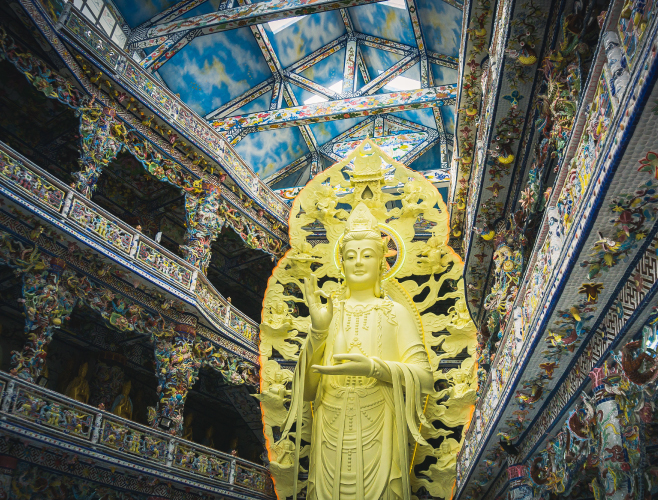
Explore top religions in Vietnam for tourists
What are the religions in Vietnam?
Vietnam's religion is distinguished by its diversity since there are several recognized faiths and religious groups.
According to statistics, there are 16 official faiths in Vietnam as of 2020, with 36 religious groups spread around the country. In Vietnam, there are six major religions: Buddhism, Catholicism, Protestantism, Islam, Cao Dai, and Hoa Hao. There are 25,000 places of worship in the United States.
If you are considering a vacation to Vietnam, it is a good idea to learn about Vietnamese religion and beliefs. Vietnam, with its rich history and various critical historical sites, provides tourists with the chance to gain a thorough understanding of the country's religious beliefs. Continue reading to extend your views and obtain a thorough grasp of Vietnamese religion.
Discover the top 6 major religions in Vietnam
1. Buddhism - the most popular religion in Vietnam
Vietnam Buddhism, the most widespread religion in Vietnam, was introduced in the early widespread Era and had significant expansion from the 10th to 15th centuries.
Buddhism flourished under the Ly-Tran Dynasties (from the 11th to the 14th centuries). During this time, King Tran Nhan Tong established the Truc Lam Yen Tu Zen sect. In Vietnam, Mahayana Buddhism is extensively practiced, but Theravada Buddhism is more prevalent in adjacent nations such as Cambodia and Laos.
As the most populous religion on the Vietnam religion map, Buddhism has over 11 million adherents, over 17,000 pagodas, and four Buddhist academies. Vietnam Buddhist Sangha is the country's official Buddhist organization.
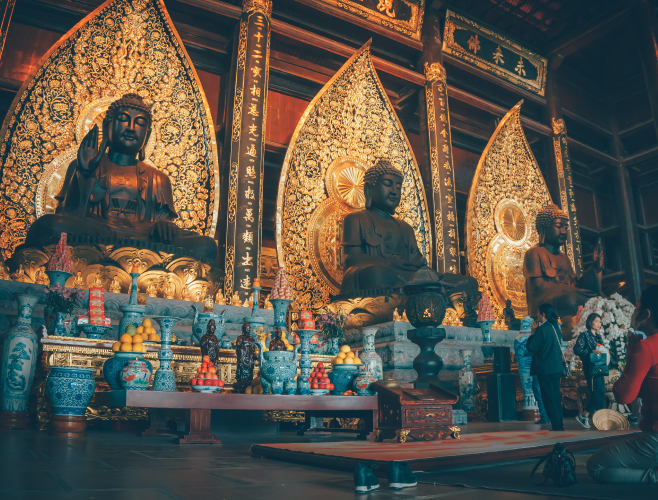
Buddhism is the most popular religion in Vietnam
2. Catholicism
Catholicism arrived in Vietnam around the later part of the 16th century. Following trade ships, Catholic missionaries from Portugal, Spain, and France brought Catholicism to Vietnam.
During the 17th century, Jesuit missionaries, most notably Alexandre de Rhodes, established an alphabetic system for the Vietnamese language based on the Latin character. This writing system is still in use on a national scale today.
When South Vietnamese President Ngo Dinh Diem, a Catholic, came to power in the 1960s, there was a profound shift in Vietnam's religion. Catholicism dominated Buddhism in Vietnam at the time.
There are currently over 6.5 million Catholics in Vietnam, with 42 bishops, approximately 4,000 priests, and over 100 religious organizations, institutions, and communities totaling over 17,000 people. The Catholic Church in Vietnam is the country's official Catholic organization.
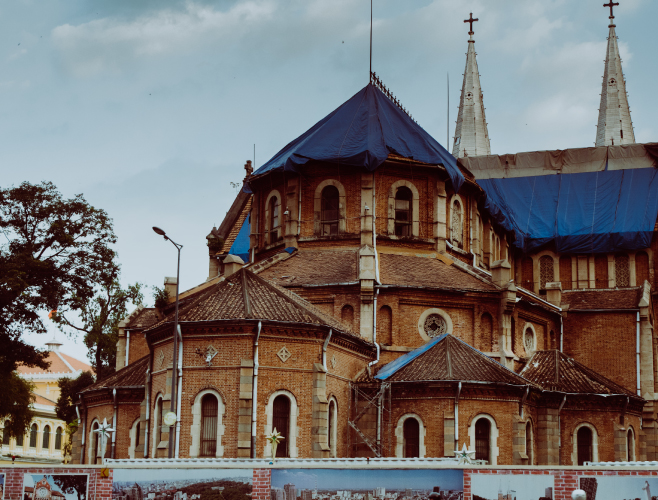
Catholicism is also one of the most popular religions in Vietnam
3. Protestantism
During the late 19th and early 20th centuries, the Christian and Missionary Alliance brought Protestantism to Vietnam. There are currently over 1.5 million Protestant adherents in Vietnam religion.
There are also over 3,000 pastors, roughly 400 places of worship, one seminary, and one bible school. The majority of Protestants in Vietnam are ethnic minorities from the northern highlands, including the Hmong, Thai, and Dao.
In Vietnam, there are two recognized Protestant organizations: the Evangelical Church of Vietnam (South) and the Evangelical Church of Vietnam (North).
4. Islam
There are some fascinating Vietnam religious facts about Islam. The Cham people make up the vast bulk of Muslims. Two groups of Cham people practice Islam: the Cham Bani in Ninh Thuan and Binh Thuan, and another group in Chau Doc, Ho Chi Minh City, Tay Ninh, and Dong Nai are called Cham Islam. Vietnam now has about 80,000 Muslim adherents and 89 places of worship. There are seven recognized Islamic groups in Vietnam.
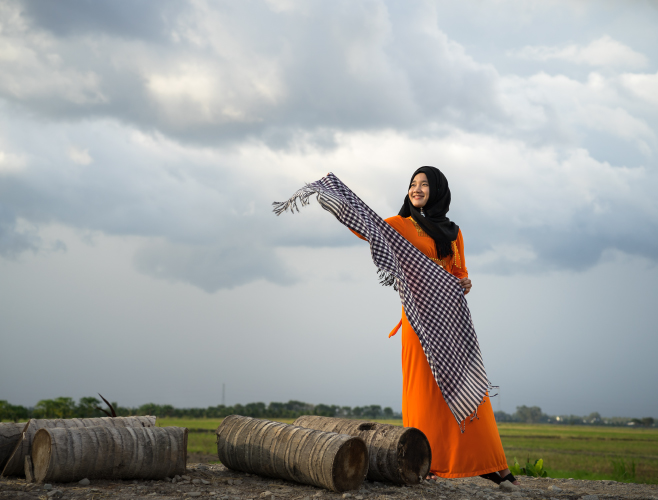
Discover the Islam religions of Cham people in the West region
5. Cao Dai
Caodaism was accepted as a religion in Vietnam in 1926. It integrates lessons from numerous religious traditions. The religion was once prohibited by the government but was subsequently permitted to function. Caodaism now has around 6 million adherents, and 7 recognized Cao Dai organizations.
6. Hoa Hao
Huynh Phu So created Hoahaoism, a reformed Buddhist group, in An Giang province in 1939. It stresses laity Buddhist practice at home and has roughly 1.3 million adherents with 94 temples in 20 regions. Followers make an altar out of a basic brown cloth at home and pray with flowers, fresh water, and incense. Hoa Hao Buddhist Church is the official Hoa Hao organization.
7. Hinduism
The Cham ethnic group follows Hinduism. The country's Hindu temples were built by the same minority community. These temples, known as Bimong, are still frequented by religious adherents. My Son, a UNESCO World Heritage site, is the most visited temple in the nation. The Nagavamshi Kshatriya caste comprises the great majority of Cham Hindus. However, a sizable proportion of these individuals are Brahmins.
8. Judaism
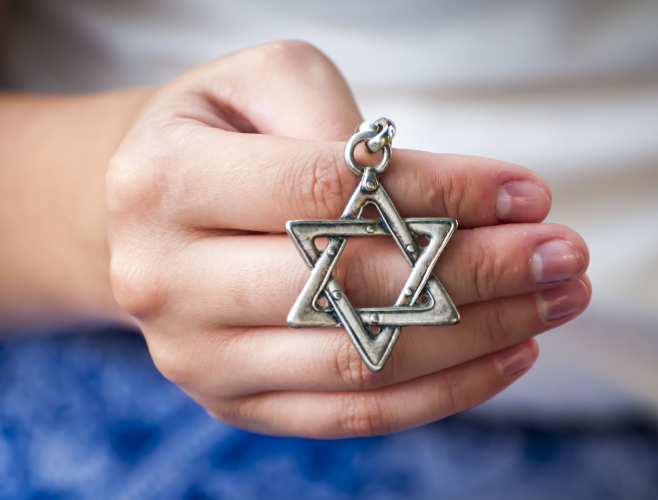
Judaism is one of the religions with the fewest practitioners in Vietnam
As their colonies in Saigon can be found reported in the famous London-based Jewish periodical published between the 1860s and 1870s, the Jews invaded the nation with the French colonization. While anti-Semites imposed harsh controls and prohibitions on Jews, these were subsequently repealed in 1945. The Jewish people were said to be fleeing their settlements when the French left the country since there was no framework in place for Jewish communal organization. In today's world, the Jewish community makes up a minuscule fraction of the total population, and the majority of these people are expatriates.
Conclusion
Vietnam is a place of several religions, all of which are freely practiced by the Vietnamese people. However, the government places some limits on any religious activity planned by any of the groups. These religions are frequently viewed negatively by the communist government, which believes they pose a danger to their reign in the country.
However, in recent years, the government has become more liberal in terms of enabling its citizens to practice the religion of their choice. Regardless of the land's different faiths and their adherents, Vietnam is endowed with breathtaking landscapes, beaches, lush green rice terraces, deep woods, towering mountains, fertile deltas, gorgeous beaches, and much more. Holidaymakers may relax and appreciate this magnificent location with its spectacular French colonial heritage by taking a tuk-tuk ride around the city's crowded streets to immerse themselves in the authentic spirit of Vietnamese living.
Get a Vietnam e-visa to explore the top major religions in Vietnam now. By obtaining an e-visa, you open the door to a fascinating journey through the diverse religious landscape of the country. With your visa in hand, you can delve into the ancient traditions of Buddhism, explore the teachings of Taoism and Confucianism, and witness the vibrant rituals of folk religions. Visit iconic temples, pagodas, and sacred sites that are integral to the spiritual fabric of Vietnam.
Engage in meaningful conversations with practitioners and immerse yourself in the rich cultural heritage shaped by these religions. Whether you seek enlightenment, cultural exploration, or a deeper understanding of Vietnamese society, obtaining an e-visa at Vietnam Immigration Services is your gateway to experiencing the top major religions that have shaped the spiritual tapestry of the country.
Related Articles
- Custom In Vietnam: A deep dive into Vietnamese traditions
- Retire in Vietnam: The ultimate guide for a dream retirement
- Trang An, Vietnam: A journey through Vietnam's natural wonder
- Vietnam Metro: The future of urban transportation in Vietnam
- Main districts of Ho Chi Minh city: Iconic landmarks & travel map
HOW CAN WE HELP?
APPLY WITH CONFIDENCE










